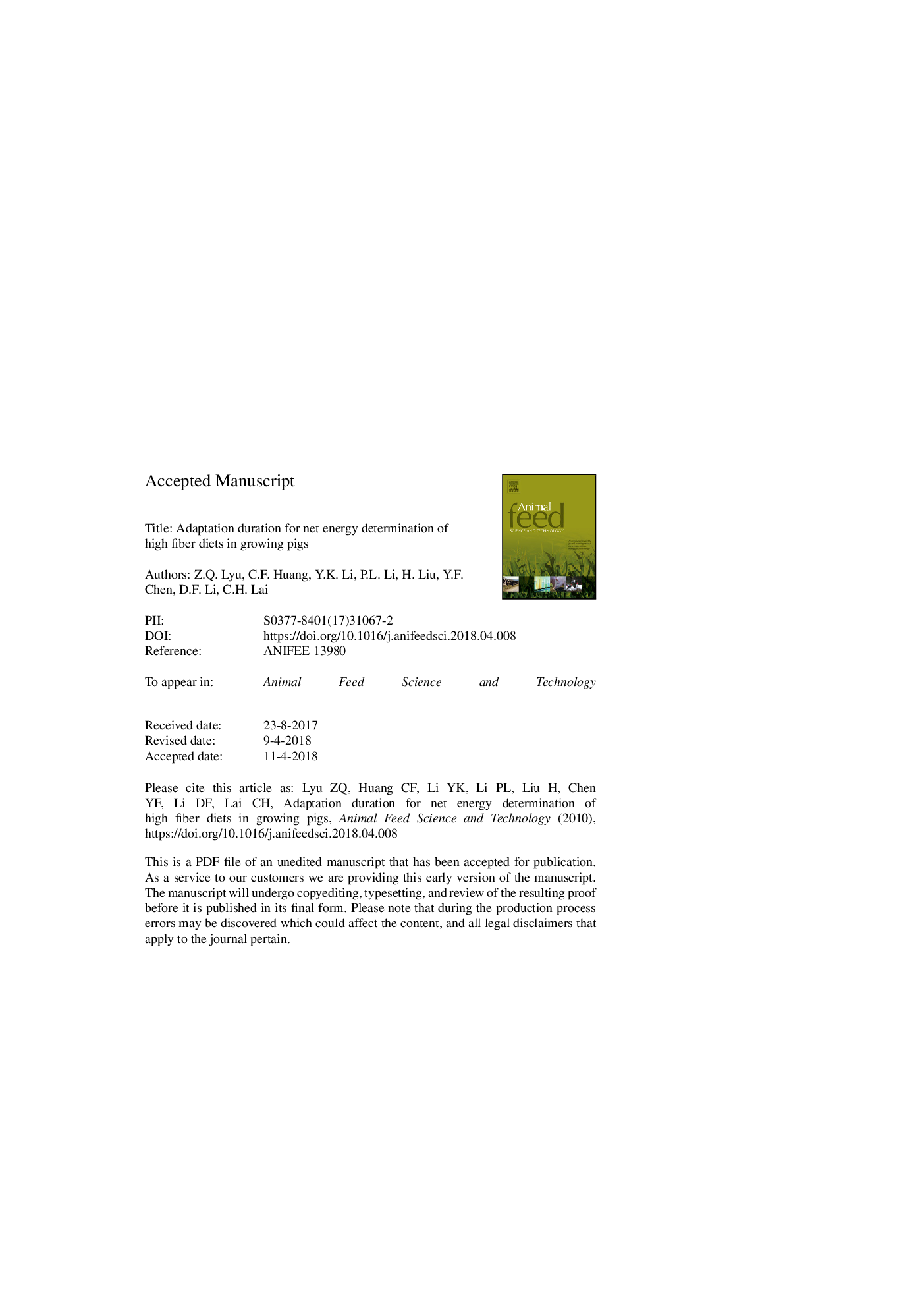| Article ID | Journal | Published Year | Pages | File Type |
|---|---|---|---|---|
| 8490942 | Animal Feed Science and Technology | 2018 | 36 Pages |
Abstract
This study was conducted to determine the optimal adaptation duration of growing pigs to high fiber diets for net energy (NE) determination and the effect of soluble and insoluble fiber on nutrient digestibility and energy metabolism using indirect calorimetry. Eighteen growing barrows (initial BW: 36.1â¯Â±â¯3.1â¯kg) were allotted in a completely randomized design to 3 dietary treatments. The 3 experimental diets included a corn-soybean meal basal diet and 2 test diets formulated to contain either 220â¯g/kg sugar beet pulp or 200â¯g/kg soybean hulls at the expense of corn, soybean meal and amino acid (AA) in the basal diet. The experiment was conducted in 3 consecutive 28-d periods consisting of a 7-d preliminary period followed by a 21-d heat production (HP) measurement period, and the HP measurement period was artificially divided into 4 adaptation duration (collection periods) of 5 d (from d 8 to d 12, d 13 to d 17, d 18 to d 22, d 23 to d 27) in order to calculate DE, ME and NE values and digestibility coefficients of nutrients within each collection period and pig. Pigs required to be adapted to the three diets for these many days before they could finish the daily feed allowance. Indeed, pigs needed 7, 12 and 10 days finishing eating the basal, sugar beet pulp and soybean hulls diet, respectively. The coefficient of apparent total tract digestibility (CATTD) of dry matter (DM), total dietary fiber (TDF), neutral detergent fiber assayed with a heat stable amylase and expressed inclusive of residual ash (aNDF), ether extract (EE) and organic matter (OM) were not significantly changed with adaptation duration for respective diets. Nitrogen retention was increased (Pâ¯<â¯0.05) in respective diets with adaptation duration. The total heat production (THP), retained energy as protein (REP) and retained energy as lipids (REL) were not changed with adaptation duration in their respective diets. Similarly, the digestible energy (DE), metabolizable energy (ME) and NE values of diets and ingredients were not changed with adaptation duration. Sugar beet pulp and soybean hulls had a negative effect (Pâ¯<â¯0.01) on energy values and CATTD of gross energy (GE), DM, OM, crude protein (CP) and EE. However, the CATTD of fiber constituent were greater (Pâ¯<â¯0.01) in pigs fed the sugar beet pulp diet than pigs fed other diets. In conclusion, considering the effect of high fiber diets on feed intake, a 12-d adaptation period will be necessary for NE determination of fiber-rich ingredients, even though the CATTD of most nutrients and energy values were not changed with adaptation duration. High fiber diets had a negative effect on nutrients digestibility and energy values.
Keywords
CATTDFHPTHPIDFRELSCFAaNDFADFWHCDDGSSDFTDFamino acidShort-chain fatty acidsInsoluble dietary fiberacid detergent fibernet energyDigestible energyMetabolizable energygross energyfasting heat productionHeat productionstandard error of the meanGrowing pigsretained energycoefficient of apparent total tract digestibilityWater-holding capacityAHPSoluble dietary fiberNeutral detergent fiber assayed with a heat stable amylase and expressed inclusive of residual ashDigestibilityorganic matterdry matterSEMRepbody weightcrude proteinTotal dietary fiber
Related Topics
Life Sciences
Agricultural and Biological Sciences
Animal Science and Zoology
Authors
Z.Q. Lyu, C.F. Huang, Y.K. Li, P.L. Li, H. Liu, Y.F. Chen, D.F. Li, C.H. Lai,
